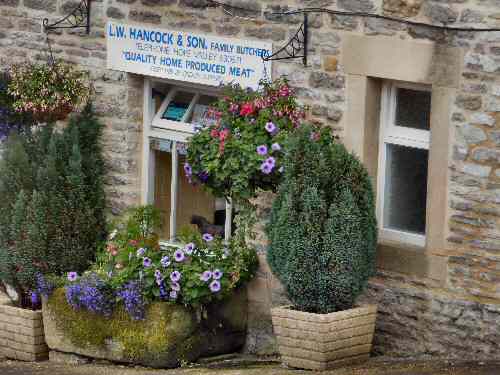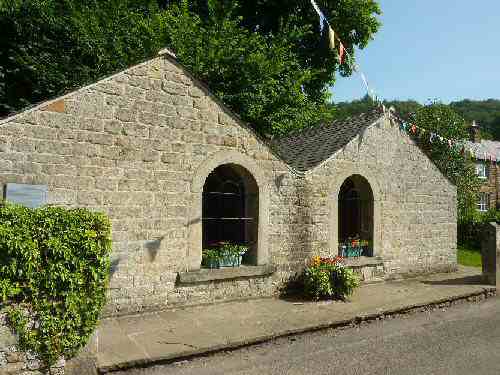STONEY MIDDLETON
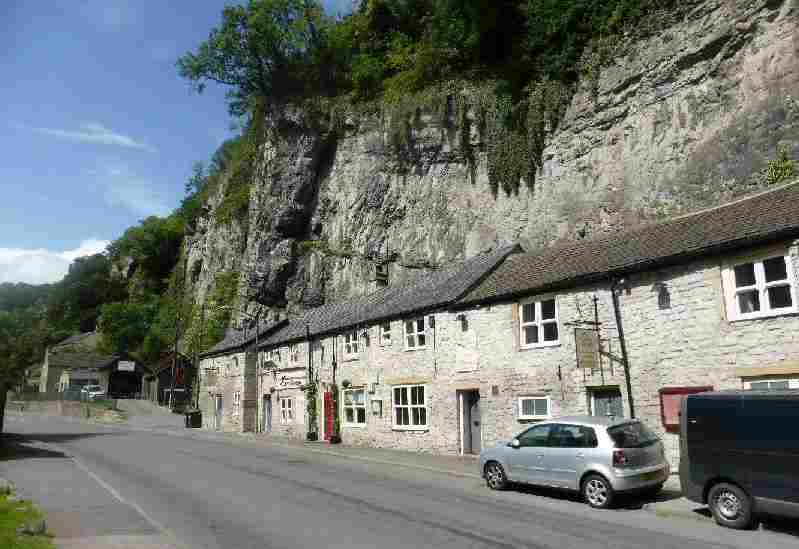
PLAN YOUR DAY OUT
Location: Stoney Middleton is on the A623 Baslow to Chapel-en-le-Frith Road. There is a lay-by on the eastern side of the village, a short distance from Lover’s Leap (SK230753).
Visit: St. Martin’s Church has an unusual and beautiful octagonal design. – Take a walk around the village, which is full of surprises, and see if you can spot the waterfall hidden away on the left-hand side of the road as you walk from the fish and chip shop towards High Street. – Seek out the Roman Baths and discover Lennon’s Boot Factory, which is still operational
Refreshments: The village has a pub, café/restaurant, curry cottage, and a famous fish and chip shop.
Walk: A most enjoyable walk with a tour of the ‘Plague Village’ of Eyam an option. The first part of the walk leads you down to the River Derwent for a short stroll along the riverbank, before turning west at Froggatt Bridge and climbing steadily up towards Eyam. After passing the Riley Graves and reaching Eyam, the Lydgate Graves provide another reminder of the horrific death toll inflicted by the plague.
Special Places of Interest in the Locality: Eyam Museum tells the dramatic story of the bubonic plague outbreak that decimated the number of village inhabitants in 1665/6. Local geology, archaeology, and social and industrial development are all covered. – Enjoy a visit to Eyam Hall for an audio tour and the adjacent Craft Centre. – Monsal Head is a famous Derbyshire beauty spot where Monsal Dale viaduct is recognised as a triumph of Victorian engineering.

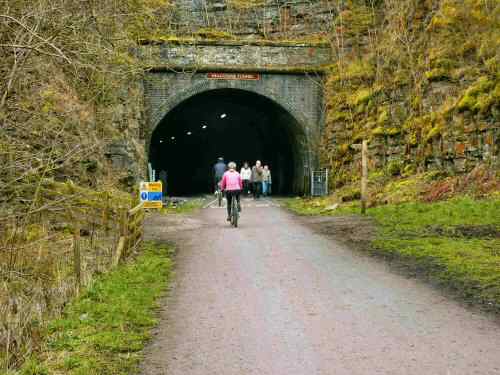
INTRODUCTION
Anyone describing Stoney Middleton as a quiet and peaceful place will likely attract strange looks from those who have only driven through the village along the busy main road. But for those who have taken the time to explore the back streets of this fascinating old village, a different view will prevail.
The A623 from Chesterfield to Chapel-en-le-Frith divides the village in half, with the houses clinging to the hillside where any space can be found. On the village’s western side, the cliffs rise almost vertically, and this is where aspiring mountaineers come to test their skills. Further to the east, the land begins to flatten out a little. However, Stoney Middleton’s High Street is said to be the steepest in the country. It was the main route through the village before the present road along Middleton Dale was opened in 1840.
LOVER’S LEAP
Lover’s Leap is a prominent limestone cliff that overhangs Middleton Dale. It acquired its name after an incident in 1762, when a young woman by the name of Hannah Baddaley attempted to commit suicide by throwing herself over the cliff top. Her lover, William Barnsley, had jilted her, and she had decided to end it all. Miraculously, her billowing petticoats acted like a parachute on the way down, until they were caught in brambles protruding from a ledge. This saved her life, and all she suffered were a few cuts and bruises. However, this story does not have a happy ending: Hannah died two years later of natural causes, still unmarried. The details of this event are recorded on an information board outside the former Lover’s Leap Café, now a restaurant that marks the location of the leap.
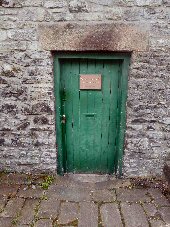
INDUSTRY
Industry has played an important part in the village’s life ever since the Romans discovered lead here. Stoney Middleton has, at one time or another, been involved in businesses as diverse as lead mining, smelting, quarrying, boot, and candle making. Today, quarrying on a large scale is carried out on the outskirts of the village.
ROMAN BATHS
The Roman Baths in The Nook still have warm thermal springs, where Roman soldiers once liked to bathe. Although there is no irrefutable proof, Roman coins have been found nearby. Stoney Middleton was undoubtedly rich in lead, and the Romans surface mined and smelted the ore wherever deposits could be found, so that they may have been actively involved close to the village.
For many years after the Roman occupation, the springs, with a constant temperature of 63 degrees, attracted the infirm. Lord Denman had the medieval bathhouse demolished and rebuilt to increase its use amongst his tenants and employees. The Parish Council and the Peak Park Planning Board have restored the building.
LORD THOMAS DENHAM
Stoney Middleton Hall, hidden behind the church, was the home of the Denman family for many years. Thomas Denman, who acquired the hall following the death of his uncle, became Lord Chief Justice of England in 1832, a position he held for 18 years. Part of the hall gardens have now been converted into an attractive housing development.
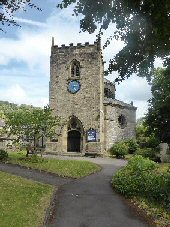
ST. MARTIN’S CHURCH
St Martin’s Church is set in a delightfully secluded square, surrounded by picturesque cottages and a stream running alongside. Like the thermal springs, the church is dedicated to the Patron Saint of Cripples and Soldiers. It has a 15th-century tower at the front leading into an octagonal church that is one of only two in the country.
THE VILLAGE
The construction of the road through Stoney Middleton in the 1840s created the need for a new Toll House. It was built in an octagonal design to match the church. After it was no longer used for its original purpose, it was converted, in the mid-1920s, into a fish and chip shop, which it remains today. It is now a Grade II listed building, the country’s only fish and chip shop to hold this distinction.
Alongside is the Grove Garden, which the Grove family gave to the community for relaxation purposes. Look carefully after passing the garden, and you will see a small waterfall partially hidden away amongst the vegetation. Lennon’s Boot Factory, the last safety boots manufacturer in this country, is to the rear. Further up the steeply rising hillside is the Wesleyan Reform Chapel.
Behind the Village Cross stands the Moon Inn at the foot of High Street. It was initially called ‘The Old Moon,’ before it was moved across the road to its present site. Consequently, it was called ‘The New Moon’ before adopting its present name. In coaching days, the ‘old’ pub was the principal posting station between Manchester and Sheffield, where horses were changed.

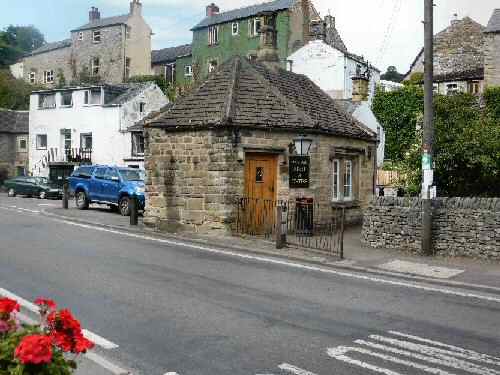
TEN FASCINATING FACTS ABOUT STONEY MIDDLETON
- The Moon Inn is now the only pub left in the village. There were 15 pubs in Stoney Middleton at one time.
- According to legend, a wealthy young couple, Alan and Clara, called at the Royal Oak one day for lunch on their way to Peak Forest to get married. Sadly, they were robbed and murdered in the Winnats Pass by five miners. The saddle used by Clara was kept at the Royal Oak for many years.
- Quarried stone was burned in large lime kilns in the village to produce quicklime, a product used to improve soil quality.
- The Cupola is a new independent visitor centre, café, and restaurant. The purpose-built building was inspired by the rich history of the former smelting mill that stood on the site in the 1700s.
- Lennon’s Boot Factory, a fourth-generation family business, has been operating in the Old Corn Mill since 1904.
- Established by William Anthony Lennon in 1897, it is England’s only remaining heavy-duty leather boot and shoe manufacturer.
- The Toll House was built to collect tolls for using the newly created road through Stoney Middleton, saving travellers from the more arduous trek up High Street, which is said to be the steepest in Britain.
- The Village Cross at the bottom of High Street was erected to celebrate the repeal of the Corn Laws, which had inflicted much hardship on people in the early 1840s.
- On High Street is the butchery business of L W Hancock and Son. The shop has been there since at least 1871.
- Stoney Middleton’s dramatic crags made it world-renowned for rock climbing. Chris Bonnington, mountaineer and conqueror of Everest, practised his skills there.
EYAM AND STONEY MIDDLETON WALK
